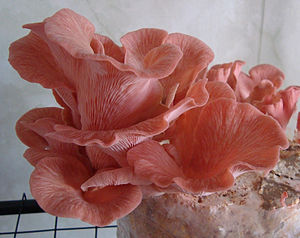Rose mushroom
| Rose mushroom | ||||||||||||
|---|---|---|---|---|---|---|---|---|---|---|---|---|

Rose mushroom ( Pleurotus djamor ) |
||||||||||||
| Systematics | ||||||||||||
|
||||||||||||
| Scientific name | ||||||||||||
| Pleurotus djamor | ||||||||||||
| ( Rumph. Ex Fr. ) Boedijn |
The Rose Seitling , Pink oyster or Flamingo oyster ( Pleurotus djamor , syn. P. salmoneostramineus ) is an agaric from the family of Seitlingsverwandten . It colonizes damaged or dead wood and forms pink-colored fruiting bodies, which are particularly popular as edible mushrooms in East Asia .
features
Macroscopic features
The rose mushroom forms tufted or roof-tile-like fruiting bodies that grow on top of each other and protrude from the bark of the infected tree. The fan-shaped, convex or flat hats reach a size of 20-50 × 30-70 mm (width × length) and are pink, white or light gray. They have a dry surface that is velvety or tomentose to the touch and a thin, tender mushroom flesh that has a sharp, pungent odor. The hats are attached to a common, only rudimentary stem that is white in color and has a felt-like surface. The yellowish or pinkish lamellae of the rose oyster mushroom are descending, relatively wide, about 4–8 cm long and close together. Its spore print is beige. The fungus initially has a longitudinal mycelium that is covered by branched rhizomorphs and is often woolly with age and runs above ground. The mushroom threads are initially white, but take on a pink hue.
Microscopic features
The mushroom spores of the rose oyster mushroom are smooth, cylindrical and measure 6.0–9.0 × 1.5–3.0 µm . His trama is dimitic , he has cheilocystids , but not pleurocystids . The hyphae of the fungus have buckles .
ecology
The natural substrate of the rose oyster mushroom is mainly hardwoods such as palm trees , rubber trees and bamboo in the tropics and subtropics , where it is widespread. It breaks down the lignin content of the wood and thus causes white rot . He is dependent on relatively high temperatures of 20–30 ° C, as well as a relative moisture content of the substrate of 95–100%.
distribution
The rose oyster occurs in the tropics and subtropics of America and Asia. Its distribution area includes South and Latin America, Southeast Asia, Hawaii, Japan and the Antilles.
Systematics
The following varieties and forms have been described for the rose oyster mushroom :
| Variety or shape | Initial description | comment |
|---|---|---|
| P. djamor f. calyptratus | ( Lindblad ex Fr. ) RH Petersen (2002) | Also Pleurotus calyptratus |
| P. djamor var. Cyathiformis | Corner (1981) | |
| P. djamor var. Fuscopruinosus | Corner (1981) | |
| P. djamor var. Fuscoroseus | Corner (1981) | |
| P. djamor var. Roseus | Corner (1981) | |
| P. djamor var. Terricola | Corner (1981) |
meaning
With its aroma reminiscent of bacon or salmon ham , the rose oyster mushroom is an exquisite edible mushroom and is cultivated primarily in Asia . The cultivation of this mushroom has a long tradition, especially in Japan, using tree stumps and wooden beams as substrates. Suitable nutrient media include sawdust from red beech , willow , poplar , or alder .
swell
literature
- Don E. Hemmes, Dennis E. Desjardin: Mushrooms of Hawaiʻi: an identification guide . Ten Speed Press, 2002, ISBN 1-58008-339-0 , p. 91.
- Malay Srivastava: A pink colored Pleurotus djamor (Rumph.) Boedijn from natural habitat of north Bihar, India. In: Current Science. 80, No. 3 / February 2001, pp. 336-337.
- Paul Stamets: Growing gourmet and medicinal mushrooms . Ten Speed Press, 2000, ISBN 1-58008-175-4 , pp. 295-300.
Individual evidence
- ^ A b Don E. Hemmes, Dennis E. Desjardin: Mushrooms of Hawaiʻi: an identification guide . Ten Speed Press, 2002, ISBN 1-58008-339-0 , p. 91.
- ↑ a b c Malay Srivastava: A pink colored Pleurotus djamor (Rumph.) Boedijn from natural habitat of north Bihar, India. In: Current Science. 80, No. 3, February 2001, pp. 336-337.
- ↑ a b c Paul Stamets: Growing gourmet and medicinal mushrooms . Ten Speed Press, 2000, ISBN 1-58008-175-4 , pp. 295-300.
- ↑ a b Markus Flück: Which mushroom is that? Kosmos, Stuttgart 2009, ISBN 978-3-440-11561-9 , pp. 87 f.
- ^ Index Fungorum. Retrieved January 9, 2010.